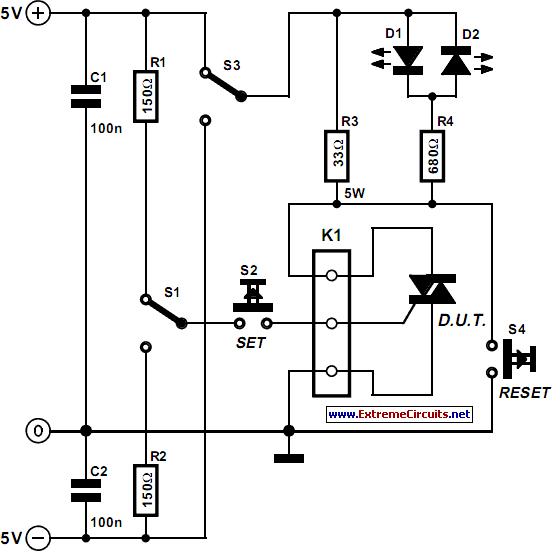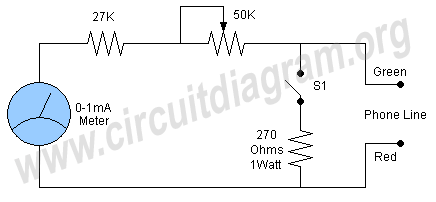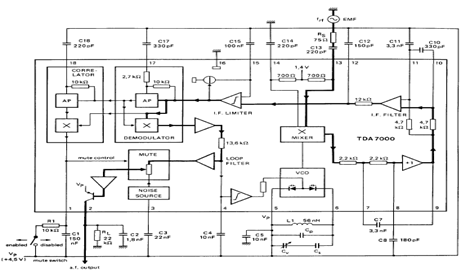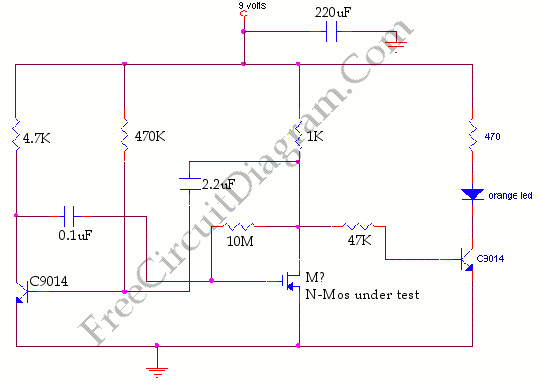
Chip carrier test
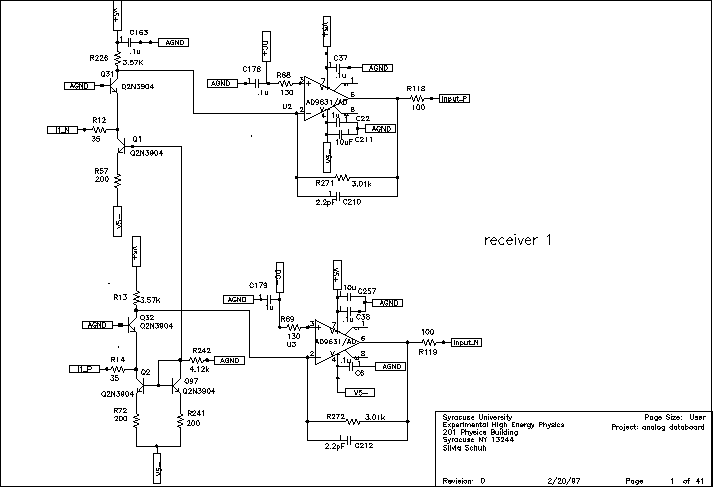
VA-RICH Power consumption: -2V current draws 34 mA, +2V current draws 5 mA. Total power consumption is 68 mW. Spark protection: Spark protection works, but the spark current burns the trace from pad to input transistor, which makes the channel float. In a few cases, spark burns a channel and one of its neighboring channels also. However, this is acceptable. Noise rejection: Preliminary study shows that noises on power supply (both +2V and -2V) are amplified. The amplification peaks at 100K Hz. The maximum amplification is around 20 to 30. VA-RICH noise: With 3pF input capacitance, the noise is about 170 electrons. VA-RICH dynamic range: Within good linearity, the dynamic range goes from -500000 electrons to 500000 electrons.
The VA-RICH circuit is designed for applications requiring precise charge detection and noise management. The power consumption specifications indicate that the circuit operates with a dual power supply configuration, drawing 34 mA from -2V and 5 mA from +2V, resulting in a total power consumption of 68 mW. This low power consumption is essential for portable or battery-operated devices.
The spark protection mechanism is a critical feature that prevents damage from high-voltage transients. However, it has been noted that the spark current can burn the trace connecting the pad to the input transistor, leading to channel floating. This issue may result in intermittent operation, especially if neighboring channels are affected. Nevertheless, the design tolerates this failure mode, indicating a trade-off between robustness and performance.
Noise rejection capabilities are vital for maintaining signal integrity, especially in sensitive applications. The preliminary studies indicate that the power supply noise, both from the +2V and -2V rails, is amplified, with a peak amplification occurring at 100 kHz. This amplification factor ranges from 20 to 30, suggesting that additional filtering or shielding may be necessary to mitigate the effects of power supply noise on the circuit's performance.
The VA-RICH circuit exhibits a noise level of approximately 170 electrons when operated with a 3 pF input capacitance. This low noise level is advantageous for high-resolution applications, allowing for the detection of small charge variations.
The dynamic range of the VA-RICH circuit is impressive, spanning from -500,000 electrons to +500,000 electrons while maintaining good linearity. This characteristic enables the circuit to handle a wide variety of input signals without significant distortion, making it suitable for applications in particle detection, radiation measurement, or other fields requiring precise charge measurement.VA-RICH Power consumption: -2V current draws 34 mA, +2V current draws 5 mA. Total power comsumption is 68 mW. Spark protection: Spark protection works, but the spark current burns the trace from pad to input transistor, which makes the channel float. In a few cases, spark burns a channel and one of its neighboring channel also. However this is acceptable. Noise rejection: Prelimenary study shows that noises on power supply (both +2V and -2V) are amplified.
The amplification peaks at 100K Hz. The maximum amplification is around 20 to 30. :-( VA-RICH noise: With 3pf input capacitance, the noise is about 170 electrons. VA-RICH dynamic range: Within good linearity, the dynamic range goes from -500000 electrons to 500000 electrons. 🔗 External reference
The VA-RICH circuit is designed for applications requiring precise charge detection and noise management. The power consumption specifications indicate that the circuit operates with a dual power supply configuration, drawing 34 mA from -2V and 5 mA from +2V, resulting in a total power consumption of 68 mW. This low power consumption is essential for portable or battery-operated devices.
The spark protection mechanism is a critical feature that prevents damage from high-voltage transients. However, it has been noted that the spark current can burn the trace connecting the pad to the input transistor, leading to channel floating. This issue may result in intermittent operation, especially if neighboring channels are affected. Nevertheless, the design tolerates this failure mode, indicating a trade-off between robustness and performance.
Noise rejection capabilities are vital for maintaining signal integrity, especially in sensitive applications. The preliminary studies indicate that the power supply noise, both from the +2V and -2V rails, is amplified, with a peak amplification occurring at 100 kHz. This amplification factor ranges from 20 to 30, suggesting that additional filtering or shielding may be necessary to mitigate the effects of power supply noise on the circuit's performance.
The VA-RICH circuit exhibits a noise level of approximately 170 electrons when operated with a 3 pF input capacitance. This low noise level is advantageous for high-resolution applications, allowing for the detection of small charge variations.
The dynamic range of the VA-RICH circuit is impressive, spanning from -500,000 electrons to +500,000 electrons while maintaining good linearity. This characteristic enables the circuit to handle a wide variety of input signals without significant distortion, making it suitable for applications in particle detection, radiation measurement, or other fields requiring precise charge measurement.VA-RICH Power consumption: -2V current draws 34 mA, +2V current draws 5 mA. Total power comsumption is 68 mW. Spark protection: Spark protection works, but the spark current burns the trace from pad to input transistor, which makes the channel float. In a few cases, spark burns a channel and one of its neighboring channel also. However this is acceptable. Noise rejection: Prelimenary study shows that noises on power supply (both +2V and -2V) are amplified.
The amplification peaks at 100K Hz. The maximum amplification is around 20 to 30. :-( VA-RICH noise: With 3pf input capacitance, the noise is about 170 electrons. VA-RICH dynamic range: Within good linearity, the dynamic range goes from -500000 electrons to 500000 electrons. 🔗 External reference
